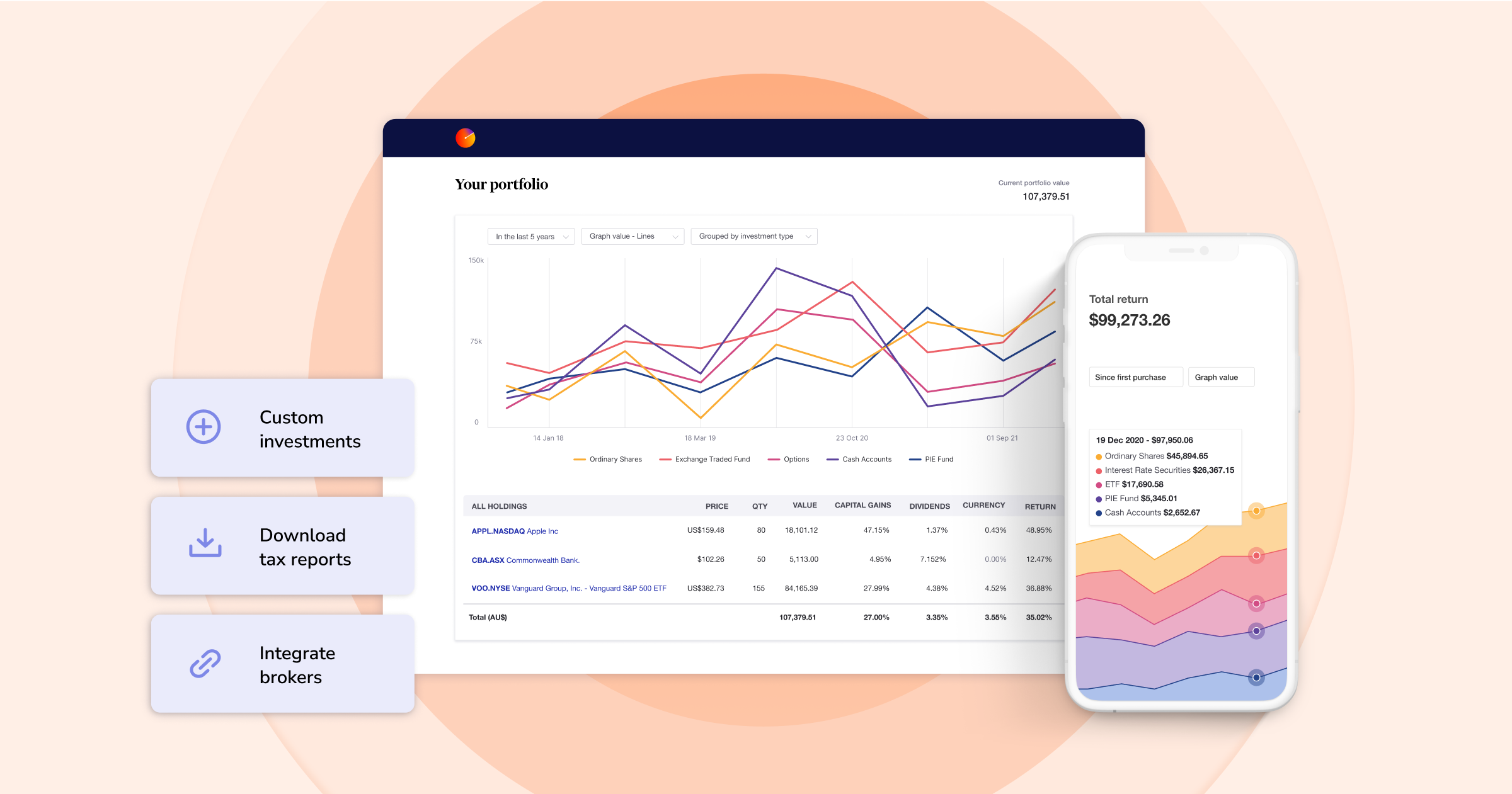Time-weighted vs. money-weighted rates of return
We often get asked the difference between time-weighted versus money-weighted (or dollar-weighted) returns when calculating portfolio performance. In this blog, we will explain the differences between both, and why Sharesight uses the money-weighted method when calculating your portfolio performance.

Time-weighted returns
Time-weighted returns (TWR) are a way to measure the performance of an investment independently of cash flows in or out of the account. This makes this measurement ideal for calculating the performance of broad market indices or the impact of a fund manager on the performance of an investment. For this reason, it is often used by professional portfolio managers to show how well the portfolio’s underlying investments performed, rather than how much money the investor added or withdrew.
At its core, a time-weighted rate of return breaks up the portfolio performance across the measurement period into smaller ‘sub-periods’ whenever there is an inflow or outflow for the portfolio. Then the performance of each sub-period is calculated, before being linked to find the ‘geometric mean’ performance across the entire period. If cash flows into or out of the portfolio during a sub-period, the period is broken down into smaller periods at this point to calculate the performance for each intra-period before then being combined to calculate performance for the sub-period.
Money-weighted returns
Money-weighted returns (MWR) measures the performance of an investment taking into account all cash flows: deposits, withdrawals, and the timing of those flows. This method of measurement takes into account both the size and timing of cash flows in and out of an investment portfolio, placing a greater weight on periods when the portfolio size is largest.
For the vast majority of investors, this is the best method of measuring portfolio performance as you control the inflows and outflows of the portfolio. Essentially, it shows the actual return you made based on the investment decisions you made, rather than just how your investments performed.
What are considered inflows and outflows from a portfolio?
Outflows include:
- The price paid for any investment
- Reinvested dividends or interest (price paid for any DRP/DRIP purchases)
- Withdrawals (cash removed from the portfolio by the investor).
Inflows include:
- The proceeds from any investment sold (cash that remains in the portfolio from any shares sold)
- Dividends or interest received (cash earned from investments)
- Contributions (cash injected into the portfolio.
Note: If there are no cash flows in or out of the portfolio during the period of measurement, both money-weighted and time-weighted rates of return will be the same.
Time vs. money-weighted returns: An example
To help explain the difference between time-weighted and money-weighted returns, let’s imagine an investor who made three trades in a particular stock over a period of two years. Let’s assume that:
- On December 1st 2015, the investor invested $1,000 to buy 1,000 units of StockABC at $1.00 per share.
- On December 1st 2016, they bought another 1,000 units of StockABC at a price of $2.00 per share (spending $2,000).
- On December 1st 2017 the investor sold their entire holding of 2,000 StockABC shares after the price fell to $1.25.
In this scenario the investor lost $500 in this portfolio over the two years.
Here’s how the return numbers for each of these performance methodologies differ in this instance:
- Money-weighted return: -12.77% p.a.
- Time-weighted (CAGR) return: 11.80% p.a.
Despite the investor losing money on the portfolio, the time-weighted return was positive. This is because the time-weighted return is only measuring the underlying performance of the shares held in the portfolio and not the actions of the investor buying into or out of those shares (inflows and outflows) or the impact of the size of those actions over the period being measured.
For more information and examples, see our video guide below:
Why Sharesight uses a money-weighted rate of return methodology
At Sharesight, we believe the time-weighted rate of return methodology is both less useful and potentially misleading for individual investors, who do control when cash flows in and out of their portfolios. We believe a money-weighted performance methodology will help you best analyse the true performance of your investment portfolio and how your choices — the inflows (buys) and outflows (sells) from your portfolio — have contributed to the returns you have achieved as an investor.
Get the full picture of your returns with Sharesight
Hundreds of thousands of investors like you are already using Sharesight to track the performance of their investments. What are you waiting for? Sign up so you can:
- Track all of your investments in one place, including stocks, mutual/managed funds, property and even cryptocurrency
- Automatically track your dividend and distribution income from stocks, ETFs and mutual/managed funds
- Run powerful reports built for investors, including performance, portfolio diversity, contribution analysis, exposure, risk, multi-period, multi-currency valuation report and future income
- See the true picture of your investment performance, including the impact of brokerage fees, dividends, and capital gains with Sharesight’s annualised performance calculation methodology
Sign up for a FREE Sharesight account and get started tracking your investment performance (and tax) today.

FURTHER READING

Every feature Sharesight released in 2025
In case you missed any of our monthly updates, here’s a full recap of all the new Sharesight features and improvements released in 2025.

Sharesight product updates – December 2025
This month's key focus was on the launch of the Tasks tab, an improved Overview page, and additional support for 20,000+ bonds on the LSE.

Sharesight's top 10 investing blogs of 2025
We look back on your favourite Sharesight blogs, from Sharesight feature explainers to users' favourite brokers, a compilation of world's best blogs and more.